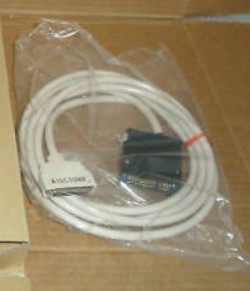Home
>> Products
>> MITSUBISHI
>> Ans/QnAs series PLC
>> Bottom plate / expansion floor / extension cable
>> A1SC05NB Extension cable
A1SC05NB Extension cable
MITSUBISHI A1SC05NB Manual And Instructions
A1SC05NB datasheetPDF datasheet
MITSUBISHI A1SC05NB Product information and technical parameters:
Brand: MITSUBISHI
Name: Extension cable
Model: A1SC05NB
Cable length: 0.45 meters
Extending cable to connect CPU main substrate and extended substrate,
According to the model can provide different cable length,
If you need to connect the AnN type expansion substrate is required,
Selection of A1SC05NB (A1SC07NB) cable.
...More relevant models >>>>
A1SC05NB datasheetPDF datasheet
MITSUBISHI A1SC05NB Product information and technical parameters:
Brand: MITSUBISHI
Name: Extension cable
Model: A1SC05NB
Cable length: 0.45 meters
Extending cable to connect CPU main substrate and extended substrate,
According to the model can provide different cable length,
If you need to connect the AnN type expansion substrate is required,
Selection of A1SC05NB (A1SC07NB) cable.
Type of input: DC leakage.
Input points: 64 points.
Input voltage: DC24.
Input current: 5mA.
Connection mode: terminal row.
Common common point: 32.
Functional block diagram language is a kind of PLC programming language, which is similar to digital logic circuit.
The function module is used to represent the function of the module,
Different function modules have different functions A1SC05NB.
Functional module figure programming language features: functional block diagram programming language is characterized by a functional module for the unit,
Analysis and understanding of the control scheme is simple and easy: function module is to use graphical form of expression,
Intuitive, for a digital logic circuit based on the design of the staff is very easy to master the programming;
Control system with complex scale and complex control logic,
Because the function module diagram can clearly express the function relation, the programming debugging time is greatly reduced A1SC05NB A1SC05NB Output type: relay.
Output points: 16 points.
Load voltage: AC120/DC24.
Load current: 2A.
Connection mode: terminal row.
Common public end points: 8 A1SC05NB.
Sequential function flow chart language is designed to satisfy the sequential logic control.
The process of sequential process action is divided into steps and transformation conditions,
According to the transfer condition, the control system is distributed in the function flow sequence,
Step by step according to the sequence of actions.
Each step represents a control function, represented by the box.
In the box, the ladder logic is used to complete the task of the corresponding control function.
This programming language makes the program structure clear and easy to read and maintain,
Greatly reduce the programming workload, shorten the programming and debugging time.
Used in the system of the size of the school, procedures for more complex occasions.
Sequence function flow chart programming language features: to function as the main line, in accordance with the functioonal flow of the order of distribution, clear, easy to understand the user program,
Avoid the defect of ladder diagram or other languages,
At the same time, the use of ladder language to avoid the use of ladder programming,
Due to the compllicated mechanical interlock, the structure of the user program is complex and difficult to understand,
User program scan time is also greatly reduced A1SC05NB A1SC05NB.
Input points: 64 points.
Input voltage: DC24.
Input current: 5mA.
Connection mode: terminal row.
Common common point: 32.
Functional block diagram language is a kind of PLC programming language, which is similar to digital logic circuit.
The function module is used to represent the function of the module,
Different function modules have different functions A1SC05NB.
Functional module figure programming language features: functional block diagram programming language is characterized by a functional module for the unit,
Analysis and understanding of the control scheme is simple and easy: function module is to use graphical form of expression,
Intuitive, for a digital logic circuit based on the design of the staff is very easy to master the programming;
Control system with complex scale and complex control logic,
Because the function module diagram can clearly express the function relation, the programming debugging time is greatly reduced A1SC05NB A1SC05NB Output type: relay.
Output points: 16 points.
Load voltage: AC120/DC24.
Load current: 2A.
Connection mode: terminal row.
Common public end points: 8 A1SC05NB.
Sequential function flow chart language is designed to satisfy the sequential logic control.
The process of sequential process action is divided into steps and transformation conditions,
According to the transfer condition, the control system is distributed in the function flow sequence,
Step by step according to the sequence of actions.
Each step represents a control function, represented by the box.
In the box, the ladder logic is used to complete the task of the corresponding control function.
This programming language makes the program structure clear and easy to read and maintain,
Greatly reduce the programming workload, shorten the programming and debugging time.
Used in the system of the size of the school, procedures for more complex occasions.
Sequence function flow chart programming language features: to function as the main line, in accordance with the functioonal flow of the order of distribution, clear, easy to understand the user program,
Avoid the defect of ladder diagram or other languages,
At the same time, the use of ladder language to avoid the use of ladder programming,
Due to the compllicated mechanical interlock, the structure of the user program is complex and difficult to understand,
User program scan time is also greatly reduced A1SC05NB A1SC05NB.
...More relevant models >>>>
Related download


 Last one:
Last one:  next one:
next one: